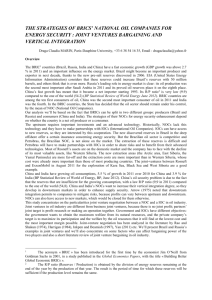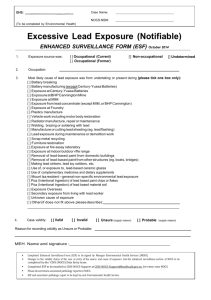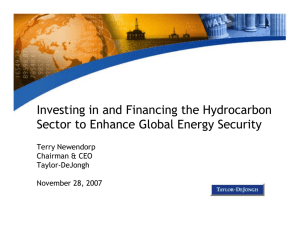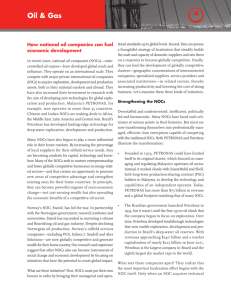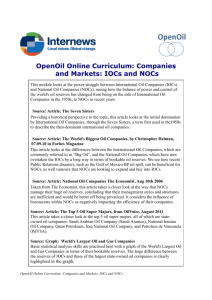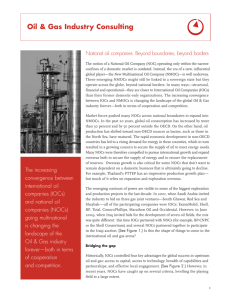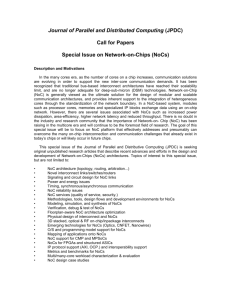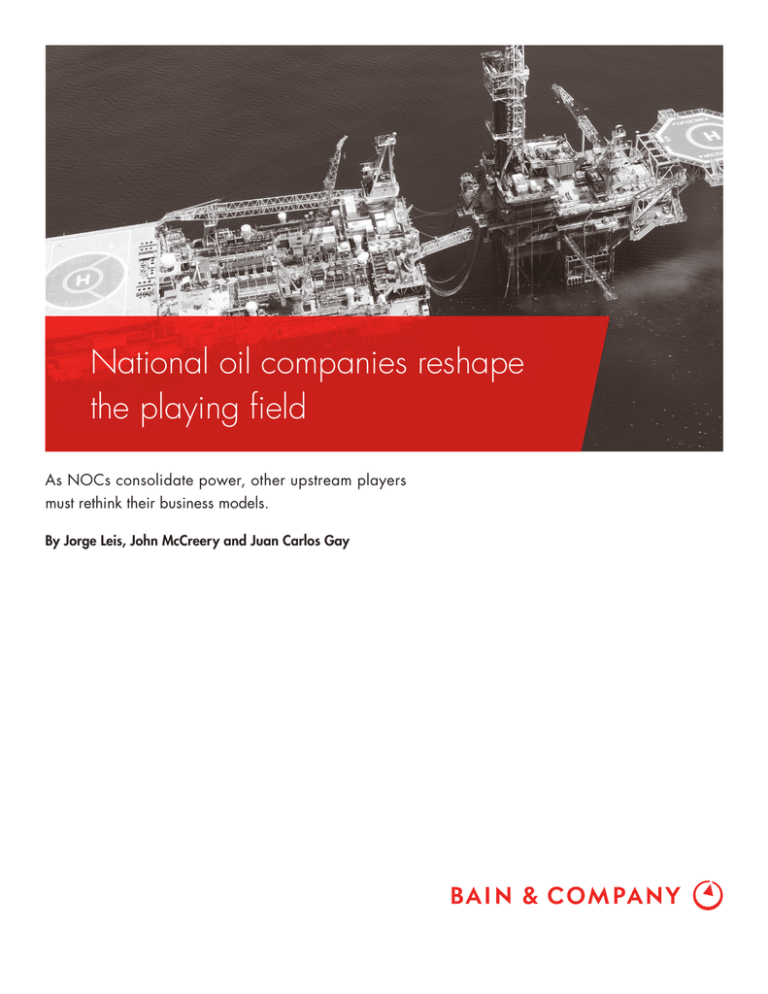
National oil companies reshape
the playing field
As NOCs consolidate power, other upstream players
must rethink their business models.
By Jorge Leis, John McCreery and Juan Carlos Gay
Jorge Leis is a partner in Bain & Company’s Houston office, where he leads
the Oil & Gas practice in the Americas. John McCreery is a Bain partner in
Singapore, where he leads the Asia-Pacific Oil & Gas practice. Juan Carlos Gay
is a partner in Bain’s London office.
The authors would like to acknowledge the contribution of Whit Keuer, a manager
with Bain & Company in Dallas.
Copyright © 2012 Bain & Company, Inc. All rights reserved.
National oil companies reshape the playing field
The rise to prominence of national oil companies (NOCs)
participants to reexamine their strategies (where to play)
has shifted the balance of control over most of the world’s
and their business models (how to win). IOCs and
oil and gas reserves. In the 1970s, the NOCs controlled
independents will confront the fundamental strategic
less than 10% of the world’s oil and gas reserves; today,
question of whether or not to embrace the contract-
they control more than 90%. This dramatic reversal has
operator service model, giving up shared resource
increased the ability of NOCs to source financial, human
ownership while providing total field management
and technical resources directly—once the exclusive
services (above and below the surface). Regardless of
domain of the large integrated oil companies (IOCs)
the answer, IOCs and independents that want to main-
and independents—and to build internal capabilities.
tain relationships with the NOCs will have to adopt a
Consequently, IOCs and independents face new chal-
more customer-centric orientation in recognition of the
lenges to remain relevant to the NOCs, as well as the
power shift to these resource holders. OSCs will also
government resource holders they represent, in all but
face fundamental strategic questions about whether and
the most difficult projects.
how far to extend their capabilities to offer integrated
services to the NOCs, above and below the surface. OSCs
As part of this trend, the NOCs are becoming increas-
will also have to keep improving efficacy and delivery
ingly comfortable and adept at procuring human and
of their traditional unbundled services, since their cus-
technical resources from oilfield services companies1
tomers will continue to procure oilfield services in this
(OSCs), which have grown dramatically in size and
way in the immediate future.
capability. These two dynamics—the shift in control
of reserves and the redefinition of operating roles in
The broad adoption of the contract-operator model could
relation to the NOCs—are leading industry participants
redefine traditional business lines that have allowed
to rethink their strategies. IOCs, as a group, are increas-
distinct groups of competitors to focus on different seg-
ingly focused on bigger and more complex plays in
ments of the oilfield services market. These changes
frontier locations (Arctic drilling, for example) and in
could pit relatively large and successful OSCs against
unconventional oil and gas fields. They are doing this to
one another— and even against IOCs and independents—
remain relevant to the NOCs and their parent govern-
more directly than in the past. Upstream players will
ments, but also because they can still acquire and control
want to defend against a changing business definition
reserves in these open-access fields. The large indepen-
while capitalizing on a new and growing opportunity.
dent oil companies are following similar strategies, usually
Challenges posed by the rise of the NOC
via smaller projects. OSCs, in addition to improving their
technology capabilities to support unconventional and
NOCs can now directly acquire the resources and ca-
frontier plays better, are developing more end-to-end
pabilities that were once the exclusive domain of the
solutions and continually extending the “ends,” that is,
IOCs and large independents. Other players in the in-
the range of their services.
dustry will need to rethink the way they respond to
their needs.
As profound as these changes have been, Bain & Company
believes the transformation is far from over. As NOCs
•
gain greater confidence in their ability to manage ever
Capital. NOCs raise equity and debt in the global
capital markets. Three of the largest NOCs (Petro-
larger and more complex projects, the recognition that
China, Rosneft and Petrobras) raised more than $27
they no longer have to enter into production-sharing
billion of debt in the first half of 2012, compared
agreements with other companies will fundamentally
with about $10 billion for the supermajors (the five
alter the competitive landscape in the industry and force
1
National oil companies reshape the playing field
largest IOCs2). In addition, NOCs often raise debt
to their oil and gas reserves has increased fivefold. The
capital at more favorable rates than IOCs. In the
share of these reserves that can be accessed by IOCs
equity markets, the six largest publicly traded NOCs
via production-sharing contracts (PSCs) is dwindling.
3
now have a price-earnings ratio of around 10 comIn addition, new conventional finds—oil that is relatively
pared with about seven for the supermajors.
easy to access on land or in shallow water—are fewer
•
Technology. IOCs once dominated research and
and smaller. According to the Petroleum Review, conven-
development (R&D) spending, but since 2005 five
tional oil discoveries peaked in the 1960s and have
of the largest NOCs have grown their research
declined steadily since. IHS Energy reports that 90% of
budgets at twice the rate of the supermajors. In 2011,
all known conventional reserves are now in production.
this group of NOCs out-invested supermajors
One bright spot is that while discoveries of conventional
(investing $5.3 billion compared with $4.4 billion
reserves may be declining, total discoveries (that is,
by the supermajors). As noted earlier, NOCs can also
including unconventionals) have gone up from an average
acquire specific expertise from OSCs, whose tech-
of 5.5 billion barrels annually between 2001 and 2006
nical capabilities are continually deepening and
to 7.9 billion barrels on average in the years since. Even
broadening. For example, the Big Four integrated
so, of the 40 major discoveries worldwide between 2006
subsurface services providers invested more than
and 2011 with resource estimates greater than 500 million
$2 billion in R&D in 2011.
barrels of oil equivalent (MMBoe), 28 are in countries
4
5
with active NOCs.
•
Project management and other technical capabilities.
With more than 90% of the world’s reserves under
As a result, reserve replacement ratios (RRRs)—a key
their control, NOCs recognize the need to improve
metric for investors and analysts because it measures the
their overall project management and technical
extent to which an operator replaces current production—
capabilities in surface and subsurface disciplines.
are under pressure, especially for liquids. Liquid RRRs
They rely on OSCs for specific capabilities and
for the top six IOCs have averaged 75% over the last 10
press IOCs and independents into contract-operator
years, although that number has risen in recent years.
service. NOCs’ hiring of mid-career professionals
Based on these reserves, the top 10 IOCs have an average
has doubled since 2009, and expatriates have also
reserve life of 13 years (and declining) compared with
been brought in as employees and advisers.
78 years for the top 10 NOCs, according to the US Energy
Information Administration. These companies face a
This shift has created significant challenges for IOCs
particularly acute challenge due to their scale, as they
and independents, calling into question the sustainability
must find significant volumes to replenish their reserves’
of their resource-ownership business model. Among
natural decline rate either through exploration or acqui-
these challenges are falling production levels: Since 2006,
sition, both of which pose challenges.
oil production by the supermajors has decreased by 2%.
Increases in gas production have offset these declines,
Meanwhile, the NOCs are claiming more M&A targets,
but overall production has still fallen by 0.3%.
accounting for about 24% of upstream deal value in 2011.
The buying spree of Chinese NOCs in particular has re-
Closely related is the difficulty of replacing reserves in
shaped the landscape in North America and Africa and left
places where oil-rich nations have limited or restricted
them holding just under 20% of the world’s shale gas re-
access to their reserves. Since the 1970s, the number of
sources. Thailand’s state-owned oil and gas company, PTT,
nations limiting or restricting foreign companies’ access
recently outbid Shell for Cove Energy’s East African
2
National oil companies reshape the playing field
assets, illustrating the competition for high-quality acqui-
recoverable volume of shale reserves is still uncertain.
sition targets faced by the supermajors. In light of all this,
In addition, the few US independents that developed
investors are becoming skeptical of the IOCs’ ability to
the technology are being targeted aggressively by IOCs
maintain their ownership model, as evidenced by their
and NOCs alike to gain access to their holdings and
declining market multiples and net asset values.
capabilities. All this makes it harder for IOCs to create
value by following their traditional strategy of globalizing
As IOCs and independents have been forced to retrench
new technologies—in this case, horizontal drilling,
to the frontier, unconventional plays and other expensive
fracking and the “drilling factory” operating model.
resources like Canada’s oil sands for reserve additions,
their production costs have risen (see Figures 1 and 2).
As for OSCs, the evolving needs of the NOCs will
According to IHS CERA, capital expenditure and operating-
continue to present significant opportunities. These
expense costs have increased by 127% and 89%, respec-
opportunities will come with some major challenges.
tively, from 2000 to the first quarter of 2012. Even taking
Managing the risk associated with integrated service
into account cost inflation during this period, reserve
contracts (ISCs) will be foremost among those. Two types
additions from the top end of the supply curve are adding
of these contracts—in particular, risk-service contracts6
materially to the cost base. In 2004, heavy oil, deep-
(RSCs) and production-enhancement contracts7 (PECs)—
water and unconventional oil accounted for 17% of
carry significant development and operational risks that
ExxonMobil’s reserves; by 2011, they made up about 50%.
can severely affect financial performance in ways and in
The higher costs of extracting these resources show up
magnitude not inherent in fee-for-service contracts.
in financial results—and in questions on quarterly
OSCs whose businesses have been based on engineering,
earnings calls. Shell recently fielded several of these,
procurement and construction (EPC), like AMEC, Wood
responding that oil sands coming online and increased
Group, Aker Solutions and Petrofac, already have ex-
production from liquid-rich shales in North America
perience dealing with these risks for surface-based
increased production costs by about 20% to $11 per
services—especially for development services. But they
barrel of oil equivalent in 2011. Other supermajors face
will have to build their risk management capabilities to
the same challenge: Chevron’s 2012 guidance for up-
operations and subsurface services, where they have
stream capital expenditure of $29 billion is about 60%
little or no experience. Subsurface OSCs, like the Big
higher than its 2010 budget. Given these rising costs,
Four, have had little opportunity to develop robust oper-
supermajors have experienced significant declines in
ating and risk management systems because they have
profitability, with average operating profit margins
worked mostly on fee-for-service contracts. They will have
falling from 15% in 2006 to below 12% in the latter half
to develop risk management capabilities to work effec-
of 2011 and the first half of 2012.
tively as the lead contractor under ISCs (see
The North American “shale gale” and other unconventional
A related challenge for OSCs is to set the optimal mix
and frontier plays offer a respite—albeit at a lower-margin,
of ISCs in their portfolios, not only to manage their
higher capital-intensive level—but it is unclear how long
risks but also to make sure they keep investing in stand-
this technology edge can help sustain the resource-
alone services. IOCs and independents will remain
ownership model in other regions. Most supermajors
important customers to OSCs and will continue to select
were late to the game in acquiring shale gas assets and,
providers based on best-in-class standalone services.
because they entered at the peak of the cycle, have written
OSCs will have to continue to invest in technology
off some of the value of these acquisitions due to the
and build capabilities to address a large and diverse
dramatic fall in the price of natural gas. The estimated
customer base.
3
Figure 3).
National oil companies reshape the playing field
Figure 1: Reserve ratios for IOCs are declining. New reserves are more likely to be found in challenging
environments such as the Arctic, in deep water or lying within complex geology
RRR <100% in last 10 years
Reserve additions’ higher cost
Supermajor (including ConocoPhillips) liquid RRR
ExxonMobil reserves
100
100%
80
100%
LNG
80
75
Conventional
60
60
40
40
20
20
Unconventional
gas
Deepwater
Heavy oil
0
0
Last 4 years (08–11)
Last 10 years (02–11)
2004
2011
Source: Bain & Company
Figure 2: As more of the IOCs’ reserves are drawn from challenging environments, their production
costs rise, pressuring margins
Production costs increasing
Operating margins declining
Average production cost per BOE
Average operating profit margin
$12
20%
16.0%
10
15
8
11.6%
6
10
4
5
2
0
00
01
02
03
04
05
06
07
08
09
10
0
11
*July 1, 2011 to June 30, 2012
Source: Company reports; Bain analysis
4
2005
2011–2012*
National oil companies reshape the playing field
Figure 3: Four contracting models have emerged with different risk-reward profiles
• Provider assumes execution risk
Productionsharing
contract
(PSC)
• Fees based on KPIs
• Projects range from long-term
production to limited sets
of services
• Fees based on nature
of service
• Value added through:
Reward
Productionenhancement
contract
(PEC)
• Value added through:
– Innovative design
– Cost-effective execution
– Technical innovation
– Low cost
– Degree of integration
– Fit for purpose delivery
• Provider assumes execution
and production risks
Risk-service
contract
(RSC)
• Fees based on tariff per barrel
• Provider doesn’t book reserves
• Value added through:
Fee
for
service
– Subsurface capabilities to
increase production
• Provider assumes
execution, production
and market risks
• Value added through:
– Surface and subsurface
capabilities
– Project management
– End-to-end field
management
• Operator books reserves
in financial statements
– Project management
Risk
Source: Bain & Company
Working with NOCs also requires meeting country-
follow their NOC parent internationally and then target
specific, local-content requirements. That can mean
other operators once operational bases are established.
substantial investments in the NOC’s home country in
Staking out upstream positions
operational facilities (as in Nigeria), research (as in Brazil)
or education and training programs (as in some Middle
To understand better the strategic options available to
Eastern countries). Finally, working in a NOC’s home
IOCs, independents and OSCs, these companies must
country has recently introduced a more direct compet-
recognize the needs of the NOCs and assess where to
itive threat: the rise in domestic competition from low-
place their current offering and where to evolve their
cost service providers that are wholly or partly owned by
value proposition to meet those needs. Our analysis
the NOC. These national oilfield services companies
of the upstream marketplace describes the different
(NOSCs) supply mature technologies at lower cost, and
types of oil and gas reserves by size and complexity,
they have stronger relationships with the national oper-
then considers the most likely partners and contract
ators. Collectively, they own about 65% of the oilfield
types (see
services market in China and about 60% in Russia. As
they grow, they are moving into international markets:
Figure 4).
Larger, less complex fields represent about 15% of the
China Oilfield Services Limited (COSL), which is majority
total number of fields and about one-third of the reserve
owned by China National Offshore Oil Corporation
base globally. NOCs control the vast majority of these
(CNOOC), is pursuing an aggressive expansion strategy
“easy barrels,” which include conventional land and
to raise its international revenue from approximately
continental shelf fields, where mature processes and
20% in 2010 to 40% by 2015. NOSCs like COSL often
technology are effective. A small but growing portion of
5
National oil companies reshape the playing field
Figure 4: The dominance of the NOCs shifts the playing field
Likely contract types/partners (or service providers)
Megaprojects
Increasing
project size
Easy barrels
•
PSCs/IOCs
• Contract-operator/IOCs, OSCs
•
Unbundled
fee-for-service/OSCs
•
Surface ISCs/surface OSCs
•
Subsurface ISCs/
subsurface OSCs
Niche plays
•
Long tails
PSCs/independents
• Unbundled fee-for-service/OSCs
• Contract-operator/
OSCs, independents
Increasing project complexity
Source: Bain & Company
the oilfield services market for these reserves is being
like Shell and BP. Meanwhile, BP and others have
captured by the NOSCs. However, there are still oppor-
shown in Iraq that RSCs can be as profitable as PECs,
tunities for both IOCs and traditional private OSCs to
especially compared with PECs for reserves at the top
offer new techniques to improve production. Shell’s 2011
end of the production cost curve (ultra deepwater, oil
agreement with PETRONAS for long-term enhanced oil
sands, Arctic). The vendor’s success depends on adopt-
recovery (EOR) in the mature Sarawak fields via a
ing a whole-field perspective (surface and subsurface)
production-sharing contract is just one recent example
across the life of a field and on delivering against key
of technology expertise enabling an IOC to deploy the
performance or production targets. This requires careful
resource-ownership model in these types of fields. But
planning and project management, innovative develop-
increasingly, NOCs are exploring ways to rely less on IOCs
ment and production techniques, operational excellence
and independents and to work directly with OSCs while
and cost efficiency. Recognizing the relatively low complex-
maintaining overall project management and procure-
ity of developing and operating these fields, NOCs want
ment strategy responsibilities, reducing the need for
contractors to deliver at low cost and use local content
production-sharing contracts. NOCs rely on their
but do so in a way that contributes to their own capability-
experience in these fields to build their own capabilities,
building objectives. The OSCs have not yet developed
which they can then use to manage increasingly more
the capabilities to deliver contract-operator services, but
complex fields.
they are beginning to develop them in their respective
areas of focus (surface or subsurface). The Big Four inte-
Recent tenders in Iraq and Iran show the NOCs’ prefer-
grated subsurface service providers, for example, are
ence for ISCs in this segment even with supermajors
investing heavily in the development of end-to-end
6
National oil companies reshape the playing field
subsurface services and delivering them as integrated
NOCs also look to the supermajors for their leadership
operations (see the sidebar, “Integrated operations in
positions in some areas of midstream (LNG) and down-
demand”). In places where NOCs want to retain overall
stream (refining) to provide expertise and access to markets
project management and greater control over surface
and technology. In some cases, this will allow IOCs to
activity, they are increasingly testing out this contract
deploy their traditional upstream business model via
model. Iraq, Russia and Mexico are already hot spots
production-sharing contracts. Large IOCs bring world-
for integrated operations, and Saudi Aramco, Sonatrach
class management skills to gas conversion projects
and publicly traded Statoil are field-testing this procure-
that signal to the international energy and finance
ment strategy. Meanwhile, NOCs still rely heavily on OSCs
community that a supply country is opening up, as with
in their traditional capacity, providing standalone services
Shell’s Pearl GTL project in Qatar.
for fees when integrated services are not warranted.
Downstream, IOCs can help the NOCs monetize proLarger, more complex fields represent about 10% of
duction by developing domestic refining facilities, thus
fields but account for half of the world’s reserves. These
ensuring access to end markets and helping NOCs capture
reserves are often remote, with complex geology and
a greater share of the economics of oil and gas production.
challenging conditions, which means a higher-risk invest-
Total’s joint venture with Saudi Aramco to build the
ment for operators, requiring novel technology and scarce
Jubail refinery to process heavy oil is an example. Another
capabilities to extract. Investment commitments are
example is Shell’s plan to build a $12.6 billion refinery
often in the tens of billions of US dollars. These “mega-
and petrochemical complex in eastern China, making
projects” are rapidly becoming the main places where
it the single largest foreign investment in China. This
sophisticated NOCs still consider sharing the molecule
project is tied to an upstream project—via an alliance
with IOCs, partnering with them to share the risk
with China National Petroleum—in which Shell is
(financial, development and operational) and tapping
planning to spend at least $1 billion per year to exploit
their technical expertise and experience. Saudi Arabia’s
China’s potentially vast resources of shale gas.
deal with Chevron to develop heavy oil fields and Rosneft’s
deal with ExxonMobil in the Arctic are two examples.
Smaller, less complex fields represent more than half
The Rosneft-ExxonMobil Strategic Cooperation Agree-
of the world’s fields but only about 10% of global reserves.
ment demonstrates another benefit to scale: portfolio
These fields represent the “long tails” of operators’
size and breadth. Rosneft and ExxonMobil will invest
portfolios and tend to be the more mature and aging
$3.2 billion for exploration, and Rosneft will receive equity
assets. Nonetheless, these fields are vital to national
stakes in three ExxonMobil projects in diverse geographies
interests. Governments in many countries rely on oil
and geologies, which will help it build experience for its
and gas revenues to meet their fiscal needs, and with
future development of tight oil in western Siberia. Even
oil prices forecast to remain well above production costs,
in this segment, as NOCs improve their skills, they will
activity in these fields is receiving much attention as
demand greater control over more complex projects,
players bring in new technologies that reverse production
further marginalizing the IOCs’ historical offering.
declines. With NOCs focusing on larger fields, being
short of skilled labor and looking to generate revenues
For “megaprojects,” NOCs and IOCs purchase few
for their governments, the benefits of contract-operator
bundled services, preferring best-in-class, standalone
services are compelling. These fields are too small to
technologies and services. These selection criteria
attract IOCs. Large independents and OSCs see an
require OSCs to invest in state-of-the-art technologies
opportunity to capitalize on their expertise. To do that,
and world-class capabilities.
they must be able to deliver the full contract-operator
7
National oil companies reshape the playing field
model (surface and subsurface) on production-enhancement
to provide contract-operator services to NOCs. The alliance
contracts and do so in a way that demonstrates geological
combines Schlumberger’s subsurface capabilities with
and geophysical expertise, innovative production tech-
Petrofac’s surface capabilities, enabling them to redevelop
niques and superior project management capabilities—
and manage larger fields than each could do individually.
all while effectively managing the associated risks of ISCs
Contract-operator ISCs require the service providers to
that deliver incremental volumes from depleted or
deploy their own capital to a specified schedule. Pemex
undermanaged fields.
recently awarded five such contracts, and PetroEcuador
has awarded similar contracts covering about 40% of its
Examples of contract-operator services being offered
current oil and gas production.
by OSCs that encompass both surface and subsurface
activities are few in this segment but noteworthy:
With NOCs looking to exert more control over their
Schlumberger and Petrofac recently signed an agreement
reserves and extend that control into ever-more complex
Integrated operations in demand
NOCs increasingly want OSCs to provide whole solutions—drilling a set number of wells, for example—
rather than discrete services, especially where the technology is easy. OSCs do not typically have all
these capabilities inhouse, so integrated operations (IO) contracts usually involve subcontracts with
third parties, providing specialized services (leasing rigs, for example), though the OSC remains the
single point of contact for the field’s operator. Many of these contracts are also based on performance
and are structured as risk-service contracts (RSCs) or production-enhancement contracts (PECs).
The benefits to the NOCs are clear. Since the OSC manages the project, the NOC can focus on
more strategic activities. Because the contracts typically require the contractor to accept some level
of risk, it mitigates the NOC’s risk. It can also cost less to buy services bundled together rather than
procuring them separately. For these reasons, IO services are gaining traction, having grown to more
than $12 billion in 2012 (excluding third-party pass-through revenues).
Most integrated operations to date have been in well construction in conventional fields for NOCs,
like Baker Hughes’s three-year $640 million contract to drill 60 wells in Iraq. Other opportunities
include “well factories” in shale fields, where operators drill hundreds of wells in a manufacturing-like
process, applying lean principles to reduce costs over time. OSCs can support the independents or
other operators in achieving cost reductions by integrating drilling rigs, well-site services and streamlined well construction (see figure on next page).
A related opportunity for OSCs or operators is integrated field development. In shale extraction, operators
typically use a “brute force” approach to field development, particularly in the hydraulic fracturing
process. They have not invested in understanding the reservoir, so only about 10% of shale wells
today have been logged. They could develop better reservoir characterization capabilities and identify
the natural fractures in the shale along with the optimal number of artificial fractures and the distance
between them. Operators could then hit the reservoir’s sweet spot and realize better production with
8
National oil companies reshape the playing field
fields, and as OSCs build a track record of delivering
attractive to the larger integrated oil companies. New
contract-operator services, these services will be deployed
finds are decreasing while the cost of extracting these
in larger and more complex fields, in essence, exploding
reserves continues to rise due to increased technical
the applicability of the contract-operator service model.
complexity, remote locations and relatively pronounced
inflationary pressures on operations due to the resource
Smaller, more complex fields account for about 20%
draw from larger fields.
of the world’s fields and about 5% of global reserves.
This segment contains a wide variety of “niche plays”
As with “megaprojects,” NOCs accept the need to offer
controlled by IOCs, large and small independents, NOCs
production-sharing contracts in “niche plays” to procure
or a combination of these players. Where NOCs con-
the required capabilities and mitigate risks. For example,
trol access, they tend to partner with independents,
Occidental Petroleum’s expertise in heavy oil allowed it
since the smaller size of these fields makes them less
to enter Bahrain’s oil fields. As with “megaprojects,”
fewer inputs. Schlumberger’s acquisition of ThruBit, a shale wireline-logging company, is one example
of a subsurface OSC pursuing this opportunity.
Integrated field management may involve other subsurface and surface activities, such as asset integrity
and flow assurance. The market for this contract-operator model is small but gaining traction as NOCs
deal with production declines in aging fields, shortages of skilled labor and governments that still
depend on their expected tax revenues.
OSCs are expanding far beyond their traditional base of well construction, offering increasingly IO to NOCs
Total
management
Integrated field management (IFM)
In addition to everything below, this adds facilities, engineering, business processes
(procurement, accounting, legal, risk, HR) and midstream work.
Integrated field development (IFD)
Managed
elements
Integration
Bundled
services
Production management (PM)
Appraisal &
field planning
Well construction
Monitor
Intervene & enhance
Seismic
Rigs
Sensors & software to
analyze performance
Well work
Subsurface modeling
Drilling
Production testing
Enhanced recovery
Artificial lift
Performance
improvement
Production
Maintenance
Plan wells
Exploration
Completions
Development
Value chain
Source: Bain & Company
9
National oil companies reshape the playing field
operators in “niche plays” prefer to contract unbundled
technical firepower, supermajors will find it harder
oilfield services since these complex fields require best-
to operate independently due to the huge challenge
in-class services.
of replacing their reserves, regardless of which
segments they focus on. Larger independents will
The boundaries of these segments are shifting. For
also find it increasingly difficult as open-access finds
“easy barrels,” NOCs will increasingly rely on ISCs,
become too small to meet their production and reserve-
avoiding production-sharing contracts whenever possible.
replacement targets. While smaller independents
IOCs and large independents are best positioned to
have less daunting production and reserve replace-
provide the full suite of surface and subsurface services,
ment needs, limited access to the “long tails” and the
but OSCs are building the capabilities to compete.
technical challenges of the “niche plays” represent
“Long tails” are serving as the test beds for oilfield services
significant obstacles. While all three classes of com-
providers to perfect the contract-operator model. As
petitors certainly have the option of extending the
they do, they will be able to compete with IOCs and the
life of the resource-ownership model by deploying
larger independents for ISCs in the “easy barrels” fields
a thoughtful acquisition strategy, we believe that
and to push the applicability of the contract-operator
such a strategy is unsustainable, except perhaps for
model into “niche plays.” These two dynamics (pushing
the smaller independents that focus on the “long tails”
“up” and “to the right” from the lower left-hand segment
being divested by IOCs and larger independents.
in the figure), coupled with the strategic intent of NOCs
to exert greater control in “megaprojects,” will put increas-
•
Partner of choice. IOCs and large independents will
ing pressure on the resource-ownership model of IOCs
continue to pursue “partner of choice” strategies to
and independents that will continue to pursue production-
secure production-sharing contracts into the foresee-
sharing contracts in “megaprojects” and “niche plays”
able future. They can only accomplish this if they
as long as practical.
maintain their competitive edge of technological
expertise and world-class project management.
Where to play, how to win
NOCs are racing to catch up, so they will need to
decide the best way to maintain that edge, whether
In light of these dynamics, all industry participants (IOCs,
it’s by recruiting the best and brightest scientists
independents and OSCs) must reassess the two key el-
and engineers and giving them the resources to
ements of corporate strategy: where to play (in which of
thrive, or by acquiring expertise through a well-
the four segments will they seek to compete?) and how
planned M&A strategy. Since they cannot know
to win (leveraging their competitive advantages to deliver).
which technologies will be most important in 10
As executives choose their strategy, they must consider
to 15 years, they will have to demonstrate an ongoing
how their business models should change to repurpose
capability to recognize critical opportunities and
their existing capabilities or acquire new ones.
technologies as they emerge and invest in them
early and over a sustained period. The effectiveness
For IOCs and independents, the strategic options include
of these strategies, and the relative competitiveness
charting a course independent of the NOCs, investing
of the players, differs by segment. As we saw above,
in becoming the partner of choice for NOCs in order
technological know-how in enhanced oil recovery,
to retain production-sharing rights and embracing the
for example, is especially applicable in the “easy
contract-operator service model.
•
barrels” fields and can sustain the resource-own-
Go it alone. Despite their traditional advantages of
ership model in this segment—but not indefinitely.
larger portfolios, deeper pockets and superior
The advantages of scale—not only in terms of
10
National oil companies reshape the playing field
size and diversity of upstream portfolios but also
to capital markets, which have traditionally valued
by participation in the entire value chain—are so
these companies based on owned reserves and
pronounced that independents will be further
production volumes.
8
competitively disadvantaged vis-à-vis IOCs for
“megaprojects,” as midstream and downstream
NOCs are already asking oilfield services companies
capabilities play more important roles in partner
to extend the range of their solutions, and the OSCs
selection for many NOCs. Independents would be
have responded by working together and separately to
better served to focus their resources on building
deliver surface-based, subsurface-based and contract-
deep pockets of expertise in technologies and
operator-based services. The fundamental strategic
management techniques applicable to “niche plays.”
questions for OSCs will be whether and how far to
And both IOCs and independents would be well
extend their services across surface or subsurface activities.
served to develop capability-based strategies aimed
The applicability of the answers varies by segment.
at securing production-sharing contracts in coun-
Regardless of their answers, OSCs will have to continually
tries with interesting potential, such as Indonesia,
improve the efficacy and delivery of unbundled services,
Vietnam, China and India. Regardless of their
because this will continue to be the most common form
strategies, IOCs and independents will have to shift
of procuring oilfield services in the immediate future.
from a mindset that seeks maximum control to one
Even here, the strategies used to drive unbundled ser-
that balances mutual interests and, above all, is
vices vary by segment. Bain sees three strategic options:
about serving the customer.
•
•
Leading-edge technology. Operators are continuing
Contract operator. For IOCs and independents,
to push the limits of technology by moving into
the fundamental strategic question is whether they
deeper waters, harsher environments, higher temper-
should embrace the contract-operator model. IOCs
atures and pressures, and more remote locations
are entering ISCs in the “easy barrels” fields as a way
in “megaprojects” and “niche plays.” To remain
to gain access to the NOCs’ larger, more complex
competitive in these segments, leading OSCs will
projects. They can use this strategy on a limited and
develop world-class R&D organizations, complete
targeted basis without jeopardizing the resource-
with an integrated product and service portfolio
ownership model—especially if it leads to substan-
strategy, rigorous new product pipeline manage-
tial production-sharing contracts. But they will be
ment, effective commercialization (including the
well served to double down on “megaprojects”9 or
right pricing strategy) and optimized infrastructure.
develop a plan to achieve leadership in contract-
They will learn and apply best practices from in-
operator services (primarily in “easy barrels”). To
dustries like high technology and pharmaceuticals,
do this, they will have to assess their capabilities
and will tap talent from around the globe, conducting
to execute ever-more stringent contracts and to devise
research not only in North America and Europe, but
a plan to fill any capability gaps, including acquir-
also in emerging markets. They will seek to under-
ing OSCs, to bring the full spectrum of necessary
stand their customers’ technological requirements
skills under their direct control. Independents face
and enter into partnerships with IOCs, NOCs,
the same set of options, but their strategies will
academic institutions and even other OSCs. The
unfold primarily across the “long tails” and “niche
question customers and investors will ask in this
plays” due to their scale. IOCs and independents
regard is not whether they have the right technological
that embrace the contract-operator model will have
capabilities, but whether they can maintain the
to find ways to signal the value of these contracts
ability to recognize important technologies as they
emerge and to act on them.
11
National oil companies reshape the playing field
•
Low-end offering. Since 2005, Schlumberger,
of surface OSCs, subsurface OSCs, equipment
Halliburton and Baker Hughes—three subsurface
providers and even independents. The challenge
OSC leaders that typically compete on their superior
for this subset of industry participants goes far beyond
technology—have lost nine points of market share
identifying the combination that delivers the most
to low-end competitors. These low-cost service
competitive contract-operator service package. New
providers use mature processes and technology
battlefields are emerging as new partnerships are
to win contracts, primarily in the “easy barrels”
being forged, introducing competitive dynamics that
segment. Other OSCs can meet this threat by
are new to the industry. The winners will have a clear
developing their own lower-tier offerings where
strategy and path for delivering a superior value
the NOSCs have a large share of the market, thanks
proposition—at acceptable risk along each step of
to their low overhead and operational separation
the journey.
from the parent company. In other markets like the
United States, OSCs should explore where they can
By virtue of the sheer magnitude of their reserves and
change the basis of competition from price to value.
the desire to exert increasing control over their development, NOCs and their governments are placing increas-
•
Contract operator. With NOCs constrained on
ing demands on the industry and redefining traditional
resources and capabilities, and intent on capturing
roles to better suit their needs. Like shifting sands on
more value from “easy barrels” and their “long tails,”
a landscape, a new set of competitive dynamics is
the benefits of contract-operator services are clear
reshaping the industry. Industry participants will be well
and compelling. OSCs are responding by expanding
served to anticipate and prepare for likely competitive
their portfolio of products and services and devel-
outcomes—and combinations. For all these players, the
oping true integration capabilities within their areas
question is no longer whether they should reexamine
of focus (surface and subsurface, respectively) and
their strategies and business models, but whether they
partnering with other OSCs to complete the offering.
have the foresight, resources, capabilities and cultural
Options for strategic partnering include combinations
nimbleness to adapt to the changes at hand.
1In this brief, we classify oilfield services companies into two broad categories: Surface OSCs provide primarily facilities-related services, and subsurface OSCs provide primarily
reservoir-related services.
2 ExxonMobil, Shell, Total, BP and Chevron
3 Gazprom, Rosneft, PetroChina, Petrobras, Lukoil and PETRONAS
4 PetroChina, Petrobras, Sinopec, Lukoil and Statoil
5 Schlumberger, Halliburton, Baker Hughes and Weatherford
6 In RSCs, fees are based on achieving specific KPIs often associated with rapid developments.
7 In PECs, fees are based on achieving production improvements and typically paid out on a tariff-per-barrel basis.
8 In fact, these scale advantages may drive a new wave of consolidation, creating “elite supermajors.”
9 Perhaps they can do so by leading the “final wave” of industry consolidation.
12
Shared Ambition, True Results
Bain & Company is the management consulting firm that the world’s business leaders come
to when they want results.
Bain advises clients on strategy, operations, technology, organization, private equity and mergers and acquisitions.
We develop practical, customized insights that clients act on and transfer skills that make change stick. Founded
in 1973, Bain has 48 offices in 31 countries, and our deep expertise and client roster cross every industry and
economic sector. Our clients have outperformed the stock market 4 to 1.
What sets us apart
We believe a consulting firm should be more than an adviser. So we put ourselves in our clients’ shoes, selling
outcomes, not projects. We align our incentives with our clients’ by linking our fees to their results and collaborate
to unlock the full potential of their business. Our Results Delivery® process builds our clients’ capabilities, and
our True North values mean we do the right thing for our clients, people and communities—always.
For more information, visit www.bain.com

